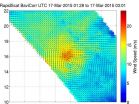(Press-News.org) In diseases such as asthma and chronic obstructive pulmonary disease (COPD), the body produces too much mucus, making breathing difficult. New research from Washington University School of Medicine in St. Louis provides clues to potentially counteract inappropriate mucus production.
"The new study lays the groundwork for developing treatments for diseases such as asthma, COPD, cystic fibrosis and even certain cancers," said senior author Thomas J. Brett, PhD, assistant professor of medicine. "It also solves a 20-year mystery about the role of a protein that has long been associated with these diseases."
The study appears March 17 in the journal eLife.
About two decades ago, the protein CLCA1 was identified. High levels of CLCA1 in cells lining the airway have long been linked with an overproduction of mucus. Studies at the time suggested CLCA1 was an ion channel, a small opening in the cell membrane that allows charged particles to flow into or out of the cell. CLCA1 was labeled a chloride channel because it appeared to be moving chloride ions across the cell membrane. In general, the movement of different ions into and out of cells govern many important processes from mucus production, to heart rhythms to brain function.
"Originally, CLCA1 was misidentified as a chloride channel," Brett said. "When cells express CLCA1, they produce chloride currents. But as we became better at understanding the three-dimensional structures of proteins, researchers in the field started to realize that CLCA proteins couldn't be channels. So the question arose, how do they activate these currents if they're not channels?"
Only seven years ago, a protein that proved to be this elusive type of channel was first discovered in mammals. Called TMEM16A, it is a channel that is ubiquitous in the cells lining the airway. Too much TMEM16A, like elevated levels of CLCA1, were also associated with the mucus-overproduction typical of airway diseases, including asthma and COPD.
The new research now has linked the two, demonstrating that increased expression of CLCA1 increases the number of TMEM16A channels present in nearby cells, according to Brett and his colleagues, including co-authors Colin G. Nichols, PhD, the Carl F. Cori Professor of Cell Biology and Physiology, Monica Sala-Rabanal, PhD, research instructor in medicine, and Zeynep Yurtsever, graduate research assistant.
"We don't think that CLCA1 actually opens the channel," Brett said. "In fact, the channel can function without CLCA1. We think it simply keeps the channel on the surface of the cells for a longer period of time. The reason you get more current is you have more channels there. You're just accumulating more holes for the ions to travel through. This is a unique finding. We don't know of any other examples of this type of interaction between a protein and a channel."
The study also suggests it may be worthwhile to investigate the larger families of these two proteins. If closely related members of these protein families also interact with each other, it could expand the implications to disorders as diverse as cancer and cardiovascular disease.
For example, TMEM16 channels and CLCA proteins have been associated with certain types of cancers including breast tumors that spread to the lungs and in some cardiovascular disorders such as irregular heart rhythms and heart failure, demonstrating a possible broad impact of future work in this area.
Brett said the team is continuing to study these interactions to learn more about how increasing or decreasing expression of the protein or the channel may influence the currents, and what impact that may have in airway diseases.
"In conditions leading to too much mucus, we may be interested in designing ways to block these currents or reduce them," Brett said. "On the flip side, these channel currents may be able to compensate for the genetic defect in cystic fibrosis, which causes mucus that is too thick and sticky. In this case, we may be interested in activating them or dialing them up."
INFORMATION:
This work was supported by the National Institutes of Health (NIH), grant numbers R01 HL119813 and R01 HL54171; the American Lung Association, grant number RG 196051; a CIMED (Center for the Investigation of Membrane Excitability Diseases) Pilot and Feasibility grant; and the American Heart Association Predoctoral Fellowship, grant number PRE19970008.
Sala-Rabanal M, Yurtsever Z, Nichols CG, Brett TJ. Secreted CLCA1 modulates TMEM16A to activate Ca2+dependent chloride currents in human cells. eLife. March 17, 2015.
Washington University School of Medicine's 2,100 employed and volunteer faculty physicians also are the medical staff of Barnes-Jewish and St. Louis Children's hospitals. The School of Medicine is one of the leading medical research, teaching and patient-care institutions in the nation, currently ranked sixth in the nation by U.S. News & World Report. Through its affiliations with Barnes-Jewish and St. Louis Children's hospitals, the School of Medicine is linked to BJC HealthCare.
Researchers at the San Diego Supercomputer Center (SDSC) and the Moores Cancer Center at the University of California, San Diego, have described for the first time the molecular mechanism of cancer development caused by well-known "resistance" mutations in the gene called epidermal growth factor receptor (EGFR).
While these mutations were known for quite a long time, the question as to why they cause cancer or make some drugs ineffective was still not answered.
The study, called "Molecular Determinants of Drug-Specific Sensitivity for Epidermal Growth Factor Receptor ...
Tropical Cyclone Bavi weakened to a depression and NASA's RapidScat instrument measured its waning winds from space.
On March 17 the RapidScat instrument aboard the International Space Station (ISS) measured Bavi's surface winds from 01:28 to 3:01 UTC. RapidScat data showed surface winds were strongest winds in the northwestern quadrant. Sustained winds were near 17 m/s (38 mph/61 kph) and weaker around the rest of the storm.
On March 18 at 0000 UTC (March 17 at 8 p.m. EDT), the Joint Typhoon Warning Center noted that Bavi's maximum sustained winds dropped to 25 knots ...
Cambridge, Mass. - March 17, 2015 - The velvet worm is a slow-moving, unassuming creature. With its soft body, probing antennae, and stubby legs, it looks like a slug on stilts as it creeps along damp logs in tropical climates.
But it has a secret weapon. In the dark of night, when an unsuspecting cricket or termite crosses its path, the worm unleashes an instantaneous torrent of slime. Two fine jets of the gluey substance spray out of openings on its head, oscillating in all directions to cast a sticky net that entraps prey and stops it in its tracks.
Captivated, ...
While unconscious race and social class biases were present in most trauma and acute-care clinicians surveyed about patient care management in a series of clinical vignettes, those biases were not associated with clinical decisions, according to a report published online by JAMA Surgery.
Disparities in the quality of care received by minority patients have been reported for decades across multiple conditions, types of care and institutions, according to the study background. Adil H. Haider, M.D., M.P.H., of Brigham and Women's Hospital, Boston, conducted a web-based survey ...
ANN ARBOR, Mich. - Drugs aimed at quelling the behavior problems of dementia patients may also hasten their deaths more than previously realized, a new study finds.
The research adds more troubling evidence to the case against antipsychotic drugs as a treatment for the delusions, hallucinations, agitation and aggression that many people with Alzheimer's disease and other dementias experience.
In the new issue of the journal JAMA Psychiatry, researchers report findings from nearly 91,000 American veterans over the age of 65 with dementia.
Data from each patient who ...
TORONTO (March 18, 2015) - People with a severe form of schizophrenia have major differences in their brain networks compared to others with schizophrenia, bipolar disorder and healthy individuals, a new study from the Centre for Addiction and Mental Health (CAMH) shows.
The study, which used a novel approach to map brain networks, was led by researchers at the Campbell Family Mental Health Research Institute at CAMH and published in this week's JAMA Psychiatry.
"Finding ways to help this particular group of people with schizophrenia is a priority as recovery is ...
COLLEGE STATION - A ground-breaking Texas A&M AgriLife Research-led study on corn has identified useful gene variations for yield increases, drought tolerance and aflatoxin resistance that could make a real difference to Texas producers in the years to come, according to researchers.
The study, titled "Genome Wide Association Study for Drought, Aflatoxin Resistance, and Important Agronomic Traits of Maize Hybrids in the Sub-Tropics" was recently published in PLOS ONE, an international, peer-reviewed, open-access, online publication.
The study included the growing years ...
From computers, tablets, and smartphones to cars, homes, and public transportation, our world is more digitally connected every day. The technology required to support the exchange of massive quantities of data is critical. That's why scientists and engineers are intent on developing faster computing units capable of supporting much larger amounts of data transfer and data processing.
A new study published in Nature Photonics by Tel Aviv University researchers finds that new optical materials could serve as the nuts and bolts of future ultra-high-speed optical computing ...
TORONTO, March 18, 2015--Researchers have defined a new bodily process in mice that may explain why blood oxygen levels are lower for patients with cystic fibrosis when they get a lung infection.
"Infected areas of the lung are not as capable as healthy tissue at adding oxygen to the bloodstream, but no one has shown why this is the case," said Dr. Wolfgang Kuebler, a scientist in the Keenan Research Centre for Biomedical Science of St. Michael's Hospital. "We've shown that the protein produced by a gene known as CFTR is required to direct blood flow away from infected ...
This news release is available in Spanish. Using discarded electronic boards, the UPV/EHU researcher Andoni Salbidegoitia has, in collaboration with international researchers, developed a system for obtaining clean hydrogen that can be used as fuel. The researchers have already registered the patent of the process in Japan.
The Chemical Technologies for Environmental Sustainability (TQSA) Group of the Department of Chemical Engineering of the UPV/EHU's Faculty of Science and Technology is aiming to make use of discarded plastic as effectively as possible from the ...


